“People know Chanderi for its silk sarees but most are not aware that Chanderi is a historical town with about 600 heritage properties”! says Muzaffar Ansari, aka Kalleybhai with a smile. He is indeed the face of Chanderi for the thousands who have visited the little town from across India as well as the world. For us, Kalleybhai unveiled tantalizing glimpses of the hidden treasures of Chanderi, enough for us to vow to ourselves to return for a more detailed and extended exploration. The experiences and places to visit in Chanderi are nothing less than a revelation of sorts. In the words of Kalleybhai, “Chanderi is an untouched place which has culture, history, handicrafts, nature, pre-historic sites, religion, and much more in one place”. Keep reading as we join Kalleybhai on our short voyage of discovery of Charismatic Chanderi and whet our appetite with some of the fascinating places to visit in Chanderi. After being mesmerized by the majesty of the Taj-ul-Masajid in Bhopal, the age-old treasures of Bhimbetka, the majesty of Sanchi and Udayagiri, we as part of the Times Passion Trails in collaboration with Madhya Pradesh Tourism reached the enchanting and enigmatic town of Chanderi.
Table of Contents
Places To Visit In Chanderi – Madhya Pradesh’s Hidden Gem
Chanderi is synonymous with its silk weaves. Weaving remains its lifeline, with around 5,000 looms that dot the town. Weaving is the occupation that supports almost the entire population of the town which numbered around 33,000 as per the last Census in 2011. Though the colourful weaves in silk did form a part of our itinerary in Chanderi, weaving a fascinating web of history that dated back to the pre-historic times, as well as stories from Chanderi Puran for us, was Muzaffar Ansari, our Chanderi Sutradhar, the man who knew the past and the present of Chanderi like the palm of his hand. But before we take you to the wonderful and historical places that are scattered like gems around Chanderi, it is but appropriate to understand a bit of the history of Chanderi as well as the legends and myths associated with it.
Buddhi Chanderi – Chanderi’s Previous Avatar

To learn about the past of present-day Chanderi, it is necessary to know about a place called Buddhi Chanderi which literally means old or aged Chanderi. Budhi Chanderi is a small village about 19 kilometres from Chanderi. It is believed that Boodhi Chanderi was earlier known by the name of Chaidnagar. Chaidnagar dates back to the times of the Puranas and finds mention in the Mahabharata.
In ancient times Chaidnagar was part of a Janapada (Republic in Vedic times) that was ruled by the Chedis. As per Puranic history, the Chedi dynasty was founded by Chidi or Ched believed to be the grandfather of Shishupala. Chaidnagar was ruled by Shishupala who in the Mahabharata meets his nemesis in the form of Krishna, his own cousin. It is believed that the etymology of Chanderi too can be traced to the Chedis. The Chedis were Chandra Vanshis or members of the Lunar dynasty and hence the evolution of the name Chanderi from the word Chandrapuri or City of the moon.
Another interesting legend from Indian mythology also has a mention of Chaidnagar. The legend of the saga of Nala and Damayanti also features Chaidnagar in a small way. In the legend, King Nala and his queen Damayanti are forced to live in the forest after the King gambles away all his possessions. Various circumstances lead to his leaving a sleeping Damayanti in the forest to fend for herself and walk away. Damyanti walks through a forest to reach a city which is believed to have been Chaidnagar, present-day Budi Chanderi. She takes refuge there in the royal palace as a maid of the queen.
Budhi Chanderi has thrown open a fascinating to the distant past of the Chanderi region. So much so that the region of Chanderi is one of the continuously inhabited regions of India. Numerous sites have been discovered in Buddhi Chanderi and these evidence the remains of palaces and temples. Ruins of the Jain, and Hindu temples from the 9th century are testimony to the splendour of the place in the early medieval period. More than 55 Jain and Hindu temple ruins have been discovered within a single fortified enclosure.
Sadly, barring a couple of temples, the others have been reduced to ruins by the ravages of time and nature. Most of the Jain temples seem to have belonged to the Digambar sect. It is also interesting to note that some of the temples had been restored during the reign of the Bundelas as they have elements of Bundela architecture. The sculptures recovered from Buddhi Chanderi belong to Vaishnavism, Shaivism, and Jainism. The principal sites of Buddhi Chanderi are the remains of a Jain monastery which encloses in its fold many temples and the remains of what is believed to be a palace, local lore identifies the palace ruins as Shisupala’s Palace though archaeological evidence dates it to the 14th-15th century AD.
Many of the beautiful remains recovered from Buddhi Chanderi are on display at the Chanderi Archaeological Museum. Buddhi Chanderi which lies in the midst of forests slowly fell into decline and the habitation shifted to present-day Chanderi around the 11th century.
History of Chanderi

Diving into the seemingly bottomless history of Chanderi, one realizes that it goes back to the pre-historic times, to the Paleolithic period. Archaeological explorations and excavations of the area have yielded sites that are classified as pre-historic, early medieval period and medieval period.
Prehistoric tools have been found in a site labelled as Tana Bana Hotel. The tools have been found from a playground situated between the Tana Bana Hotel and Pranpura village. Middle Paleolithic tools have also been recovered near the Battisi Baoli of Chanderi. The Paleolithic tools like handaxes, cleavers, discoids, and other tools made of quartzite have been discovered in the region.
In a site known as Nanon located about 22 kilometers from Chanderi on the road that leads to Mungaoli, painted rock shelters have been discovered. The rock paintings which are probably the early expressions of Man depict scenes of everyday life like hunting, pictures of different animals, etc.. The rock paintings have been dated from the Mesolithic to the Neolithic period.
There are over 12 sites around Chanderi and many being discovered on which archaeologists are working today. What is revealed of the ancient history of Chanderi seems only to be the tip of the iceberg. One can only imagine of the grandeur of the Chanderi region in the past from the eloquent stories told by the silent stones of the past.
The Great Southern Highway – Dakshinapatha
The rich heritage of ancient India that stretched from North to South and East to West was connected by two great trade routes called Dakshinapatha and Uttarapatha. These routes which followed the course some of the great rivers of India served as the vibrant lifelines that helped in the travel of not only goods and commerce, but also ideas, culture, religion, art, architecture, and much more. The Dakshinapatha was a route that started from Magadha in present-day Bihar to Pratishthana in Aurangabad district. The route provided a gateway from the north to the Deccan. Chanderi situated strategically near this trade route thrived and prospered throughout the passage of history.
Chanderi’s More Recent History
Artifacts have been found near Chanderi which trace its history to the Gupta Period. After that, the region thrived under the rule of the Gujjar-Pratihara dynasty who ruled over Central India from the 8th Century to the 11th century. They were connoisseurs and patrons of art and architecture and the wonderful temple architecture of Central India in places like Khajuraho and Bateshwar bloomed during their period. It is interesting to note that though the power of the Gujjar-Pratihara dynasty declined elsewhere, an offshoot of the dynasty continued to rule over Chanderi till almost the middle of the 13th Century. Many of the ruins of the temples found in Chanderi and the sculptures that are now housed in the Chanderi Archaeological Museum are from this period.
In the mid of the 13th century, Chanderi came under the rule of the Delhi Sultanate. The region was captured by Ghiyasuddin Balban on behalf of Sultan Nasiruddin who was the eighth Sultan of the Slave Dynasty (Mamluk Dynasty) to sit on the throne of the Delhi Sultanate. Chanderi was under the Delhi Sultanate for quite some time. It was only in the 16th century that the Rajput King of Mewar, Rana Sanga, captured Chanderi and installed Medini Rai as its ruler. Medini Rai had been a trusted loyalist of the Malwa Sultan and had been instrumental in helping him consolidate his hold over the region of Malwa. However, he fell out with the Sultan and became a trusted lieutenant of Rana Sanga and continued to be a thorn in the flesh of the Delhi Sultanate till his defiant death in what is known as the, “Battle of Chanderi”. Medini Rai’s last battle was with the army of the Moghul Emperor Babur who invaded Chanderi. Though he had been given an option to surrender and give up Chanderi in exchange for Shamshabad, the brave Medini Rai chose to fight till his last breath and etched his name as a braveheart in the history of Chanderi.
Chanderi finds mention even in the autobiography of Akbar, Ain-e-Akbari, where he describes it as a town with 14,000 stone houses, a staggering 384 bazaars, around 12,000 odd mosques and more than 360 vast resting places for caravans.
Ibn Batuta visited Chanderi towards the middle of the 14th century on his way to Malabar. He describes Chanderi as a bustling commercial town full of bazaars, full of people trading in various goods.
In the middle of the 16th Century the Bundelas took over Chanderi and ruled over it till the beginning of the 19th century when it came under the Sindhias of Gwalior and remained with them till India’s independence, except for a short period in between
Indeed Chanderi is a place waiting to be discovered with the canvas of its history stretching way back in time. With 13 sites discovered in and around Chanderi, and many more being discovered regularly, an unofficial count of around 43 different sites, the region’s history, definitely deserves being labelled as a World Heritage City.
Places To Visit In Chanderi – Madhya Pradesh’s Hidden Gem
Chanderi Museum – A Window To Chanderi’s Glorious Past

Museums are always fascinating and the Archaeological Museum in Chanderi is no exception. It was appropriate that we started our exploration of Chanderi from the museum as it provided a deep and insightful perspective of the region and its history. The museum is very well maintained with spacious galleries. In fact, we were reminded of the National Museum in Phnom Penh, Cambodia, while visiting the Chanderi Museum.
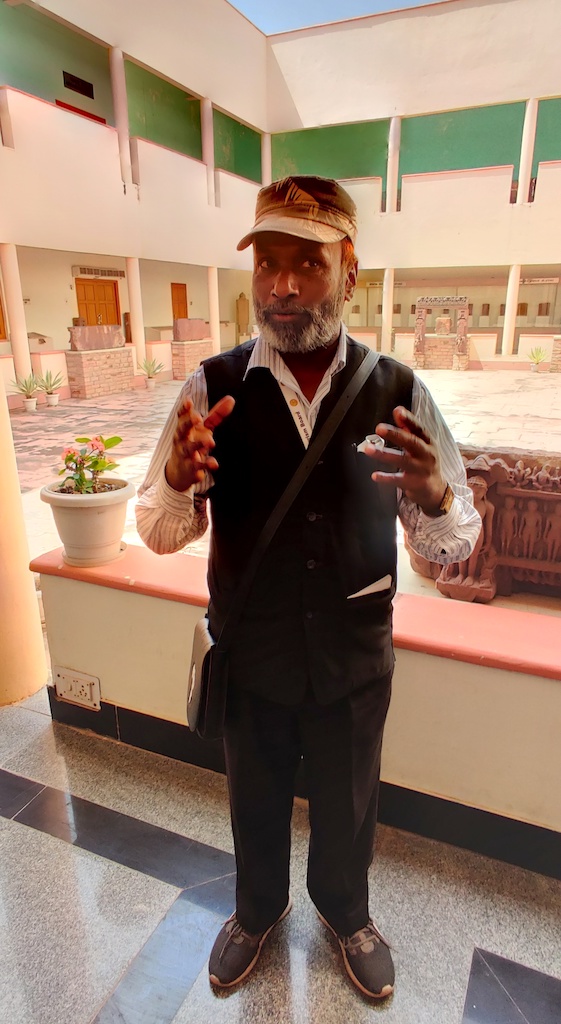
We were met by Kalleybhai at the entrance of the Museum and he took us around the museum, giving us a snapshot of Chanderi’s history across the centuries. The Museum is set in the midst of beautifully landscaped gardens and is a visual treat. Right at the entrance to the museum we were intrigued by a strange-looking and huge image that looked down upon us, it looked like the image of the Hindu God Shiva, but was different and awe-inspiring and at the same time fearful.
“This is a replica of the original 7-feet statue that was found in a village called Tala in the Bilaspur district of Chattisgarh,” explained the archaeology expert Padmashri K.K.Muhammed who was traveling with us. The statue which is now protected by the Archaeological Survey of India dates back to the Gupta Period, between the 4th and 5th Century AD. In fact, the original sculpture fascinated him so much that he had a replica made, and it was that replica that now stands at the entrance to the Chanderi Museum.

The statue of Shiva is unique and something that we have never seen in any temple, anywhere in the world. The statue is made up of different creatures from head to toe. It is believed to symbolize the Pashupatinath form of Rudra. The incredible statue of Shiva silently conveyed the message of the omnipresence and omnipotence of Shiva as the lord of the Universe.
On the head of Shiva is a coiled snake while two peacocks who are traditional enemies of snakes adorn his shoulders. They are in harmony when one with Shiva. The eyes are those of a crocodile while the two hands also emerge from the jaws of a crocodile. The crocodile symbolizes Ganga who is always closely associated with Shiva. The nose is made up of a lizard. Two fishes make up the moustache while the chin consists of a crab. The genitals of the naked statue are represented by a moving tortoise. Apart from different animals and birds, there are 9 faces on the statue of Shiva that can be interpreted as the 9 planets, signifying that not only is Shiva the lord of all living beings (Pashupatinath), but the entire universe is comprised in his being.

Awed by this riveting form of Shiva, we followed Kalleybhai inside the museum and he took us on the journey right up till the beginning of human existence in the region of Chanderi. The museum itself is filled with sculptures and other artifacts discovered in the surrounding area, most of them dating back to around the 8th and 9th centuries AD, though some date back to much beyond that period. Most of the sculptures are from the ruins of the Jain and Hindu temples of the region. The museum is organized in four galleries. A gallery each is dedicated to Jainism, Vaishnavism, and Shaivism, while there is another common gallery dedicated that showcases the history of Chanderi.
As we moved spellbound in the galleries, exquisite sculptures of Hindu Gods and Jain Tirthankaras stared at us silently, the remains of a glorious era of Indian history.

An intriguing Varaha sculpture stands in the centre of a gallery riveting your attention. It is a different interpretation of Vishnu’s Varaha avatar from the one found in Udayagiri. Here, Vishnu is seen completely in the form of a Boar. What makes this sculpture unique are the minute carvings that grace the entire body of the Boar. The entire cosmic universe seems to be represented on the body of the Boar, one can find different Gods and Goddesses of the Hindu pantheon, the planets, saints, celestial beings, etc.. The sculpture of the Varaha was discovered in a site called Toban near Chanderi and dates back to the 9th Century AD.
Sculptures in sandstone of Shiva, Vishnu, Parvati, and other Hindu Gods greet you at every corner of the museum. Jain Tirthankaras look benignly from their pedestals, while ancient coins grab your attention. Many of the collections have been donated to the museum by Kalleybhai’s family collection. Make sure you include the Chanderi museum at the top of your list of places to visit in Chanderi.
Chanderi Fort – Chanderi Ka Kila or Kirti Durg

Atop a hill overlooking the town of Chanderi stands the Chanderi Fort. This Chanderi monument beckons visitors with its imposing facade and makes it one of the top 10 best places to visit in Chanderi. The fort hides within its fold many interesting monuments that tell stories of valour, desperation, and tragedy associated with the fort. Standing on the border between Bundelkhand and Malwa, the Chanderi fort was of strategic importance as it was the gateway to the Deccan. The fort is one of the most important places to visit in Chanderi.
The fort has a 5- kilometer wall running around it and is nestled at a height of about 71 meters above the town of Chanderi. It was built during the 11th century by the Pratihara king Kirti Pal and hence the fort is also known as Kirti Durg. The fort has been rebuilt and renovated a number of times by different kings who held sway in the region. Within the ramparts of the fort can be found, a palace as well as a mosque. The main gate of the fort is known as Khooni Darwaza, a grim reminder of the tragic battle that Medini Rai and his soldiers fought with Babar’s army.
Johar Smarak

A simple memorial stands inconspicuously in a corner by the side of the fort. A few women dressed in colourful attire stand near the canopy which protects the memorial stone that has scenes from the battle of Chanderi carved on it along with a scene that depicts the Jauhar as well as one of the ceremonial Shiv Puja. The wind blows across the monument as we listen to the poignant story associated with the monument. Just beyond the monument is a gorge and this is where thousands of women jumped into the fire, fearing the impending invasion of Babur’s army which was at the doors of the fort. Babur himself was astounded at what the women and men had done and he has expressed himself about this in his autobiography, Babur Nama.
One of The Lesser-Known Place To Visit In Chanderi – Baiju Bawra Memorial

A tomb surrounded by sepulchral silence stands a little distance away from the Johar Smarak. A single stone marks the tomb as that of the musical legend of India, Baiju Bawra, who was a contemporary of Tansen. Legend has it that he was first associated with the royal court of Chanderi and later moved to the court of Raja Man Singh Tomar of Gwalior. It is believed that he could light lamps, melt stones, bring rain, as well as make flowers boom with the power of his singing. It is believed that he died in Chanderi in the year 1610 after battling typhoid. Today the man who is believed to have melted stones with his singing, himself lies in an obscure corner beneath a stone, unsung.

Near the tomb of Baiju Bawra are many cactus plants, and on each of the leaves can be seen scratched the names of couples. It is believed that if couples scratch their names on these leaves, their love shall blossom.
Badal Mahal Chanderi

Beautifully landscaped gardens. Immaculately maintained walkways. An imposing structure that rises to the skies but is aesthetically pleasing to the eyes. This is what awaits you as you step into the Badal Mahal. The structure known as Badal Mahal gate stands as a symbol of Chanderi and is one of the iconic landmarks of the town.

Ironically Badal Mahal is neither a palace nor a gate. The structure that is referred to as Badal Mahal Gate or Badal Mahal Darwaza does not lead to anywhere. The structure rose in the 15th century and was constructed by the Sultan Mahmud Shah Khilji. The structure rises to about 100 feet from the ground. Two minarets stand on either side of exquisitely carved arches with intricate lattices and religious motifs.
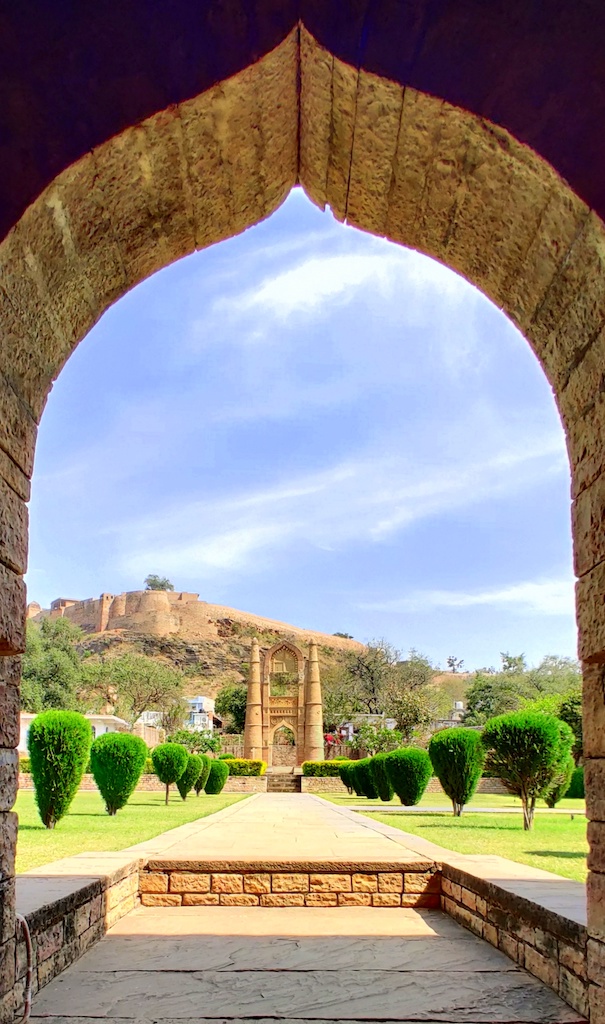
The gate also represents the secular character of the Chanderi region as it has religious symbology from Hinduism, Islam, and Christianity. The Badal Mahal is believed to have been a venue for the reception of royal visitors. These would be ceremonially received here before being escorted to the palace. The Badal Mahal must figure in your list of places to visit in Chanderi.
Jama Masjid
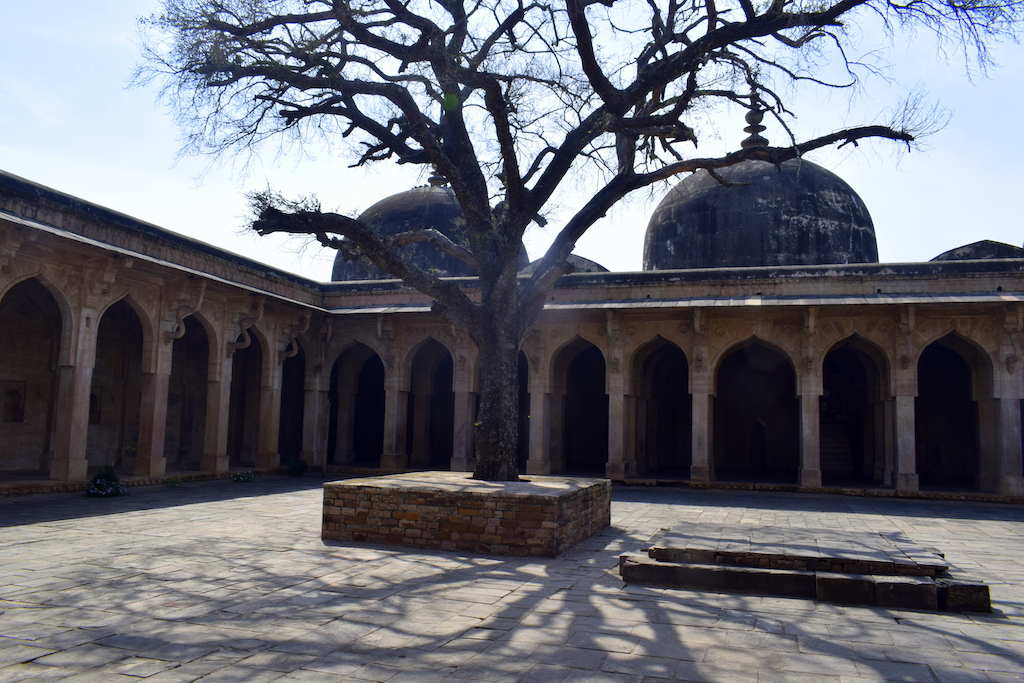
Just opposite the Badal Mahal is a very old mosque that presents an almost surreal picture. This is the Jama Masjid that dates back to the 15th Century. The mosque is a beautiful example of the fusion of Islamic and Malwa architecture.
The grand domes are topped with traditional Padmakosa (Lotus), Kalasa (Pitcher), and Amalaka. A vast courtyard is in the centre of the Masjid. The quibla wall has been divided into beautiful and ornamented Mihrabs.
Kati Ghati or Kati Darwaza

A girl sits on a lone bench beside a massive gate that seems to have been cut into the rock. A bus moves through the gate and stops near the girl who boards it and the bus moves away. Does that sound familiar? It should ring a bell if you have seen the hit Bollywood movie by the name, “Stree”.

The bench was in front of us and saw was the massive gate. What was missing was the presence of Shraddha Kapoor. We were at Kati Ghati, one of the landmarks of Chanderi and the locale for the last scenes of the movie Stree.
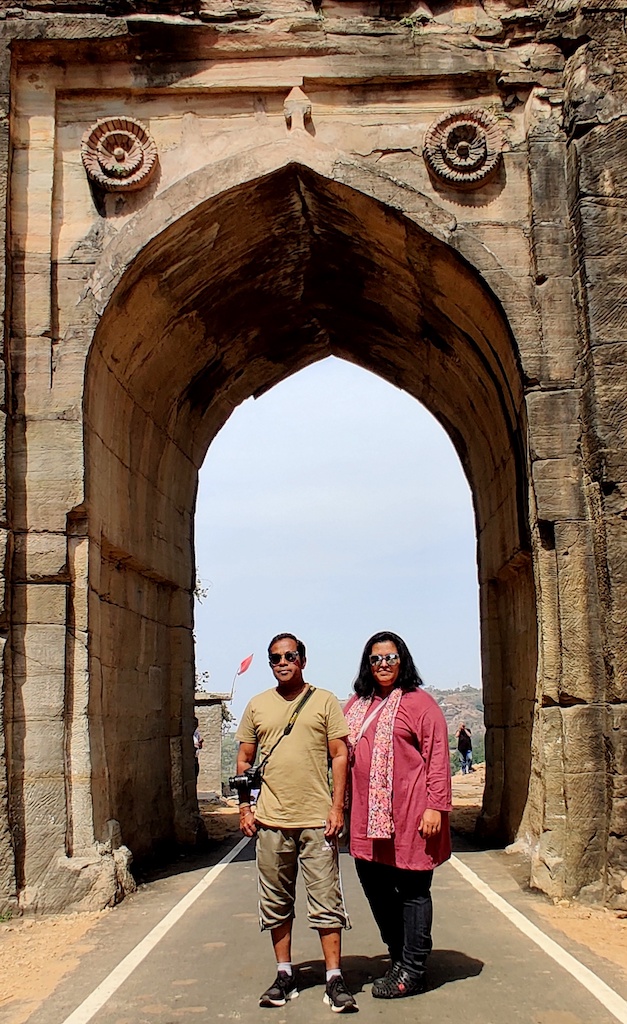
Kati Ghati as the name implies is a gate that was not constructed, but rather a passage cut into sheer rock. The gate was excavated under the orders of Jiman Khan in the year 1490 under the reign of Ghiyasuddin Shah. The dimensions of Kat Ghati are a height of 80 feet, length of 192 feet and width of 39 feet.
There are many stories and myths associated with the gate which render it with a mysterious aura and these stories lead up, right to the construction of the gate.
Legend has it that Jiman Khan who was the administrator of Chanderi under the reign of Ghiyasuddin Shah wanted to impress the Sultan who was arriving there. So he thought of having the gate built. But the task was easier said than done. Sheer rock had to be sliced to form the gate. No one came forward to take up the humungous task till a person came forward and agreed to get the work done subject to certain conditions. He wanted complete independence and absence of any sort of supervision when the work was being done, and that he would name his fees after the work was completed. He boasted that he would give a surprise once the gate was complete.
Soon it was time for Jiman Khan to glimpse the finished work. He was amazed at what he saw, the massive rock seemed to have dissolved and in its place stood a broad passage through the rock. He was pleased and thought that this would surely humour the Sultan Ghiyasuddin Shah. But before he gave full vent to his joy, he noticed an anomaly, the gate was devoid of hinges, which meant that no door could be fixed on it, leaving the passage wide open to intruding enemies! Realizing his blunder the man who along with his retinue of labourers had cut through solid rock, took leave of Jiman Khan, never to be seen again. It was said that he committed suicide immediately after that.
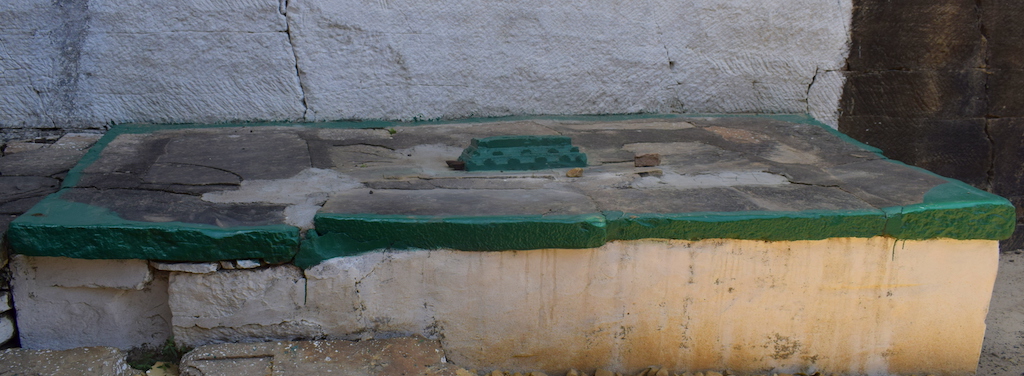
The tomb of the man who was responsible for the massive task of cutting rock and building the Kati Ghati lies just outside it. Local folklore, contributes to the Chanderi horror story which goes that the place is even today haunted by the spirit of its architect who becomes a door and stands in the passage at night, not allowing anyone to pass through.
It is likely that an observation room was built on top of the gate where sentries would be posted to keep watch over the passage in lieu of a door. Rock cut steps that lead to the top of the gate point towards this fact.
An inscription near the gate gives information about the construction of the gate. What is interesting is the fact that this is in four languages, local Bundeli, Sanskrit, Arabian, and Persian. Another interesting aspect of the inscription is the mention of the Hindu God Ganesh.
A few scenes of the Bollywood movie – Stree was shot in Kati Ghati.
Chanderi Silks – Handloom Park

Chanderi is of course, synonymous with its silk weaves. The art of weaving exquisite designs especially with gold dates back to the 13th century. In the initial years, the exquisite weaves were for the adornment of the royal families, however, with the passage of time and innovation, things have changed a lot. Though almost every home in Chanderi has a loom or two, the Government has now set up a Handloom Park, where weavers are provided assistance in the form of procurement of raw materials, working capital, infrastructure etc.

We visited a couple of handloom units in the Handloom park and had an opportunity to observe the making of the Chanderi Saree. Chanderi Handloom Park is definitely one of the interesting places to visit in Chanderi for an understanding of its rich tradition of weaving.
| Click to buy Chanderi Silk Sarees, Chanderi Cotton Silk Saree, Chanderi Fabrics |
|---|
Some More Places To Visit In Chanderi
Chanderi in Madhya Pradesh is a veritable treasure house of ancient sites and monuments. Our trip to Chanderi was too short to cover all of them and we hope to return to explore the wonders of Chanderi at leisure. Here is a list of places to visit in Chanderi.
- Khooni Darwaza
- Shehzadi Ka Roza
- Battisi Bawdi
- Koshak Mahal
- Ramnagar Palace
- Shehzadi Ka Roza
- Nizamuddin Auliya Family Tombs
- Parmeshwar Tal
- Bada Madarsa
- Shri Digambar Jain Atishaya Kshetra Khandargiri
The Archaeological sites of Buddhi Chanderi, Nanon, Momen, Tabon or Tubonji, Sita Mani, Behti Math, Rakhetra or Gadheina, Sehrai, Hasari, Naderi, Bhadiya-Kho, Singh Sagar, Lakhari, Bithla, Surail, Silwara, Baishra, Mani Chanderi, and many more within a 50- kilometer radius of Chanderi. These sites are filled with ruins of Hindu and Jain temples and other structures. For those really interested in history and archaeology these are some of the most important places to visit in Chanderi.
Best Time To Visit Chanderi
The best time to visit Chanderi is during the winter months. The months between October to March is ideal as the climate is cool and pleasant. The weather in summer can be a little hot, especially as one would need to walk around for exploring the sites of Chanderi.
Chanderi Trivia and Films shot in Chanderi
- Chanderi grabbed eyeballs when the superhit Bollywood film Stree was shot here
- Other popular Bollywood movies shot in Chander include Rajneeti and Sui Dhaaga
- Chanderi, MP – Jeep Bollywood Trails with Zareen Khan was shot in Chanderi
- Chanderi has laid claim to the status of a World Heritage City
- Chanderi is home to a unique amalgamation of cultures owing to its strategic location on one of the major trade routes of India
Chanderi Tourism
How To Get to Chanderi
- Chanderi, District – Ashoknagar in Madhya Pradesh, India is a small town of around 32,000 and located on the border of Bundelkhand and Malwa
- Bhopal to Chanderi distance is about 214 kilometers
- Chanderi to Jhansi is around 107 kilometers
- To reach Chanderi town, one can fly either to Bhopal or Gwalior and then drive down to Chanderi
- The nearest railway station to Chanderi MP is in Lalitpur at a distance of about 40 kilometers
If you are planning a trip to Chanderi in Madhya Pradesh, India you can book a cheap flight through TripAdvisor or Agoda or CheapAir or Cleartrip or Makemytrip or Priceline right here. If you are planning to travel by road to Chanderi from Bhopal or Gwalior, some of the options to reach Chanderi are by self-drive car or cab or bus.
Where To Stay In Chanderi

Chanderi is a small town, but with Chanderi tourism picking up owing to the sheer number of attractions and places to visit in Chanderi, many hotels and resorts have come up. Some of the properties include the picturesque MPT Kila Kothi, Chanderi run by Madhya Pradesh Tourism as well as the budget hotel – Tana Bana Hotel.
If you are looking to book a hotel in Chanderi, you can do that right here. You can book Chanderi hotels through TripAdvisor or Cleartrip or Agoda or Makemytrip or Priceline and save a lot by getting the best savings on booking your stay.
| Click to book the best hotels in Chanderi, MP or best hotels in Madhya Pradesh |
|---|
Chanderi FAQ

How does one get to Chanderi?
Chanderi can be reached by road either from Bhopal, Gwalior or Jhansi.
What is Chanderi famous for?
Chanderi Madhya Pradesh is known all over the world over for its exquisite silk weaves.
Who constructed the Chanderi Fort?
The Chanderi Fort was constructed by a king named Kirti Pal.
Where is Chanderi fabric from?
The raw material for Chanderi’s magical weaves comes from Karnataka and other places.
Which are the places to visit in Madhya Pradesh apart from Chanderi?
Some of the important places in Madhya Pradesh are Sanchi, Khajuraho, Orchha, Gwalior, and Bhopal, and of course, the different places to visit in Chanderi and its surroundings.
Shopping in Chanderi

Apart from the various historical places to visit in Chanderi, one of the top things to do in Chanderi is shopping. Yes, you read that right – Shopping in Chanderi! During ancient times the Chanderi sari used to be the favourite of Royal families. Chanderi sarees are known to be one of the best handlooms in India. Chanderi sarees that is a mix of silk with cotton is quite famous here. One can buy Chanderi saree online.
Chanderi Fabrics can be bought online. Below is a list of various garments/ Chanderi fabrics that can be procured:
- Chanderi Silk Sarees
- Chanderi Cotton Saree
- Chanderi Suit
- Chanderi Dupatta
- Chanderi Silk Suit
- Chanderi Dress Material
- Chandri Silk Dress Material
- Chanderi Kurti
- Chanderi Cotton Sarees
- Chanderi Cotton Silk Saree
- Chanderi Silk Kurtis
- Chanderi Silk Dupatta
- Chanderi Silk Kurta
- Chanderi Fabric
| Click to buy Chanderi Silk Sarees, Chanderi Cotton Silk Saree, Chanderi Fabrics |
|---|
Planning a trip to Madhya Pradesh
Attractions are many in Madhya Pradesh and if you are trying to decide on what to see in MP or what to do in Madhya Pradesh, then book online right here places to see in Madhya Pradesh and cover attractions in Bhopal and MP.
| Click here to know more and book Best Attractions in Madhya Pradesh |
|---|
We hope you liked our Chanderi post and it serves as a Chanderi travel guide to help plan a trip to this enchanting town. An ocean of experiences and a treasure trove of heritage await you at Chanderi. We hope you discover the rare treasures of Chanderi at the earliest. There are so many places to visit in Chanderi that once is definitely not enough and more visits are necessary. Do let us know your thoughts through the comments section.
Recommended read:
Sanchi Stupa – A Timeline Of Buddhism In India
Pench National Park – Tiger Reserve in Madhya Pradesh, India
Places To Visit In Pachmarhi, Madhya Pradesh, India
Tajul Masajid – Bhopal’s Crowning Glory
Kutni Island Resort – Khajuraho’s Pristine Getaway
Do You Love Traveling?
Do you want to know how to travel the world? We have put together a very useful travel resources page with best travel tips. Go check it out now.
Thanks for visiting our site Voyager – imvoyager.com and taking the time to read this post!
If you wish to collaborate/work with us then reach us at [email protected]
We’d love if you’d comment by sharing your thoughts on this post and share this post on social media and with your friends.
[shareaholic app=”share_buttons” id=”27413782″]
Follow our journey on our social media channels:
Facebook Twitter Instagram Pinterest YouTube
60+ Million Users Trust TripAdvisor With Their Travel Plans. Shouldn’t You?
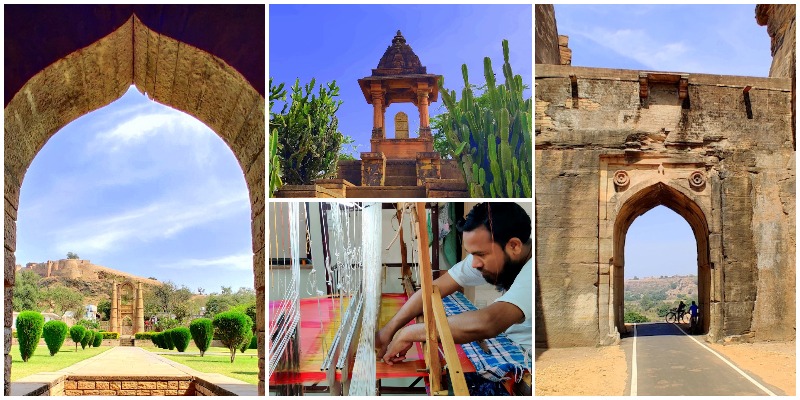












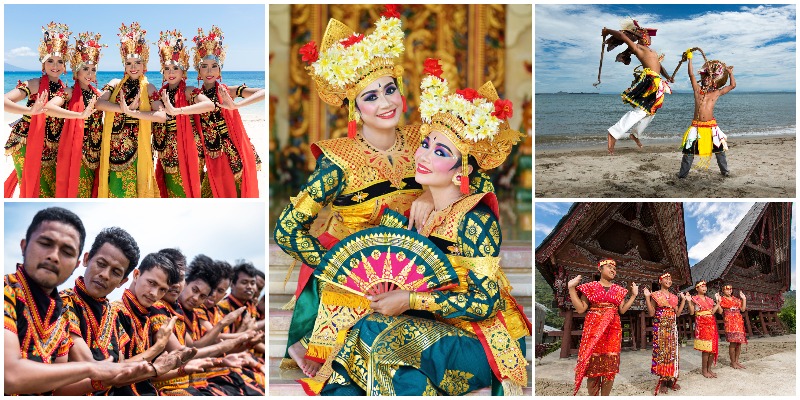

That is a very insightful post on Chandheri, I have heard a lot about chandheri sarees but haven’t been to chandheri or any other place in Madhya Pradhesh yet. But whenever I will plan a vacation for MP, I will make sure I have Chandheri in my itinerary.
Your post is so much in detailed. Kudos for writing it.
I didn’t knew Stree movie was shot here until now.
Also, I liked the Bada Mahal.
This is such an amazing guide to tourists. Even I am tired of routine places . This would make a wonderful getaway and a trip to these places would be so rich in culture and heritage
First of all that’s such a thorough & indepth Blog about the place& secondly, yes we hardly know much about the place. It has such beautiful relics to visit & enjoy. That now i have it on my Travel list. A great read.
Honestly I didn’t know about this place. Chanderi silk saree I know but wasn’t aware of its origin. I would love to visit this place some day. Loved reading your article and pictures of this place.
This post makes me hungry for travelling. I love exploring new places and Chanderi happens to be a great place.
I have heard of chanderi slik but all the rest is absolutely a surprise for me. I like the way to cover a place in all posible dimensions. Amazing research.
Our Chanderi trip got cancelled in the last moment and we have yet to get over that. We have been to so many places in Madhya Pradesh and have never been disappointed. Chanderi for some reason has been eluding us. And now that we know there is so much to do at Chanderi through your blog, we are regretting not doing it even more.
I love traveling and this places tempts me. Gonna travel here super soon.
Chanderi silk sarees are the best … I’m yet to meet a woman who hasn’t praised about Chanderi silk. I wish to go to Chanderi this year.
What a nice and detailed post. You have covered almost everything about the ancient place.
I have been here! Still remember the sarees and how nicely they weave … MP has such beautiful heritage places and want to go there again.
Chanderi looks exquisite indeed. The statue of Shiva in the entrance of the museum is making me curious. Of course, the weaves have my heart.
Amazing place for family picnic. Good historical reference. Very clean and well reconstructed monuments. Calm place to watch sunrise and sunset. Great thoughts.
That’s very deep dive in the history behind chanderi handloom and it’s charismatic city with such a beautiful architectural heritage
My mom loves silk sarees from Chanderi… They are so gorgeous… Loved reading about the beautiful place! Nice post!
This is a well detailed article on chanderi, I didn’t know a lot about it. And the explanation of the statue of shiva is done so well here.